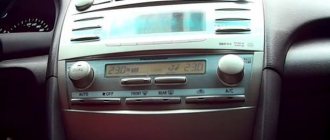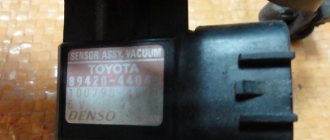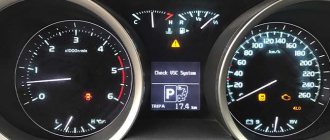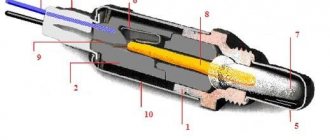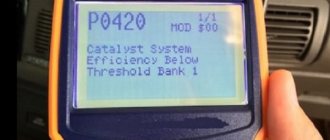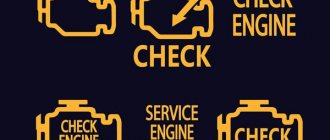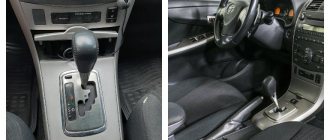What does error P0031 mean?
Trouble code P0031 is a general trouble code that indicates that the engine control module (ECM) has detected that the oxygen sensor 1 (bank 1) heater circuit voltage is too low. The vehicle's ECM uses an oxygen sensor to monitor the oxygen content of the vehicle's exhaust gases. The ECM uses the signal received from the oxygen sensor to regulate the fuel/air mixture ratio of the engine. The most optimal ratio of air and fuel in the mixture supplied to the engine cylinders is 14.7:1. It is this ratio that is necessary to achieve maximum engine power and optimal fuel consumption.
The oxygen sensor heater is used to heat the internal components of the oxygen sensor to provide faster feedback to the vehicle's ECM. This is necessary to reduce emissions of harmful substances from the vehicle's exhaust gases when starting the engine, especially if the engine is started in a cold state.
SFI SYSTEM, Diagnostic DTC:P0031, P0032, P101D
DESCRIPTION
The air-fuel ratio sensor provides a voltage* that corresponds to the actual air-fuel ratio. This voltage is used as a feedback signal to the ECM, through which the ECM adjusts the air-fuel ratio. The ECM detects deviations from the stoichiometric composition of the air-fuel mixture and regulates the duration of fuel injection. If the air-fuel ratio sensor malfunctions, the ECM cannot accurately control the air-fuel ratio.
The air-fuel ratio sensor is a planar type sensor and is equipped with a heater that heats the solid electrolyte (zirconium cell). The heater is controlled by the ECM. When the intake air volume is low (low exhaust gas temperature), current begins to flow through the heater, warming the sensor and providing an accurate determination of oxygen concentration. In addition, the sensor and heater are of narrow type. The heat generated by the heater is transferred to the solid electrolyte through the aluminum, thus accelerating the activation of the sensor.
To achieve a high degree of purification of exhaust gases from carbon monoxide (CO), hydrocarbons (CH) and nitrogen oxide (NOx), a three-component catalytic converter is used. To achieve maximum efficiency from a three-way catalytic converter, the air-fuel ratio must be precisely controlled and maintained at near stoichiometric levels.
*: The value changes in the ECM. Since the air fuel ratio sensor is a current output element, the current is converted to voltage by the ECM. If measurements are taken, a constant voltage will be observed at the air fuel ratio sensor and ECM connectors.
Technical Tips
- When any of the following codes are detected, the ECM goes into limp mode. In emergency mode, the ECM turns off the air-fuel ratio sensor heater. Emergency operation continues until the ignition is turned off.
- Although DTCs refer to the oxygen sensor, these codes refer to the air fuel ratio sensor.
- The ECM controls the amount of current through the heater using a pulse width modulation signal. A relay on the +B side of the circuit is used to control the air fuel ratio sensor heater circuit.
| DTC No. | Malfunction | DTC Detection Condition | Faulty area | MIL | Memory |
| P0031 | Low current in the oxygen sensor (A/F) heater control circuit (bank 1 sensor 1) | The air fuel ratio sensor heater current is less than 0.8 A even when the air fuel ratio sensor heater ON duration is at least 30% (1 trip diagnostic logic). |
| Lights up | DTC is stored |
| P0032 | High Current in Oxygen Sensor (A/F) Heater Control Circuit (Bank 1 Sensor 1) | The air-fuel ratio sensor heater current reaches the upper limit (1-trip diagnostic logic). |
| Lights up | DTC is stored |
| P101D | A/F Sensor Heater Circuit Performance (Bank 1 Sensor 1 Stuck On) | The air-fuel ratio sensor heater current is higher than the preset level when the heater is not operating (1-trip diagnostic logic). |
| Lights up | DTC is stored |
Causes of error P0031
The P0031 code will appear if the vehicle's ECM detects that the O2 Sensor 1 (Bank 1) heater circuit voltage is too low (compared to the manufacturer's specification). The most common causes for this error include a faulty heated oxygen sensor, damaged electrical wires or connector, a faulty heating element inside the sensor, or a power or grounding problem.
In rare cases, the problem may be a faulty engine control module (ECM).
Diagnosis and problem solving
Trouble P0031 can only be caused by the oxygen sensor heater circuit or the oxygen sensor itself. Diagnostics usually begins with checking the sensor wiring. Typically the heated oxygen sensor comes with four wires.
Two wires go directly to the heater circuit, and the other two are for powering and grounding the sensor. You may need a wiring diagram for your car. To be sure you are testing the correct set of wires.
Wiring check
Test the heater circuit using a digital multimeter or volt-ohmmeter. Consult your vehicle's wiring diagram to determine the exact pinout of the ground connector.
The reading should be close to the battery voltage. If this is not the case, then there is most likely a problem with the sensor's power supply.
It is also necessary to check the grounding. To do this, you need to connect the positive terminal of the battery to the red wire of the multimeter. And the black wire to ground to check the grounding of the circuit. The result should be 12V, if not then this indicates a grounding problem at the sensor.
Sensor check
If the power and ground are ok, then the next option is to check the sensor heating element. To determine if it has an open circuit or high resistance.
Set the volt-ohm meter to Ohm scale, check the resistance of the heater circuit using the electrical diagram as a reference.
Make sure you have disconnected the O₂ sensor. The heater circuit inside the sensor should have little resistance. Exceeding the limit value indicates a break in the heating part. Therefore, the oxygen sensor will have to be replaced.
What are the symptoms of code P0031?
- When this error occurs, the Check Engine light on the vehicle's dashboard will light up, indicating a malfunction.
- If the vehicle's ECM detects low voltage in the oxygen sensor heater circuit, it will put the engine into limp mode.
- Staying in limp mode can cause a number of vehicle handling problems, which can vary depending on the make and model of the vehicle.
- The vehicle will remain in limp mode until the error is resolved.
- There may be a drop in power, rough idling, and unstable engine operation.
Symptoms of malfunction
The main driver symptom of P0031 is the MIL (Malfunction Indicator Light) illumination. It is also called Check engine or simply “check light”.
They can also appear as:
- The “Check engine” warning light on the control panel will light up (the code will be stored in the ECM memory as a malfunction).
- In some cases, the engine control module (ECM) may put the vehicle into limp mode.
- Sometimes there may be no symptoms despite a stored DTC.
When this code appears, the car can continue to move, but the problem must be corrected as soon as possible. To prevent potential problems such as sensor circuit failure and increased fuel consumption. If the problem is ignored for a long time, unstable operation of the engine is possible, as well as damage to other components.
How does a mechanic diagnose a P0031 code?
First, the mechanic reads all the stored data and error codes using an OBD-II scanner. He will then clear the error codes from the computer's memory and test drive the vehicle to see if the P0031 code appears again. If the error code appears again, the mechanic will visually inspect the heated oxygen sensor for damage, as well as check the ground and measure the voltage at the sensor.
The mechanic will then carefully check any associated electrical wires that may have been damaged due to excessive heat due to high exhaust temperatures.
How serious is P0031?
When a P0031 error occurs, the Check Engine light on your vehicle's dashboard will illuminate, indicating a problem. Failure of the heated oxygen sensor may cause the vehicle's ECM to not be able to properly regulate the fuel/air mixture in the engine. The vehicle's engine may run erratically. It may also increase fuel consumption and damage other vehicle components. If this code is detected, it is recommended that you contact a qualified technician as soon as possible to diagnose and resolve the error.
Often, if the Check Engine Light comes on immediately after starting the engine, the OBD-II system can be reset and the vehicle will continue to operate normally.
What repairs can fix the P0031 code?
To resolve error P0031 you may need to:
- Clearing error codes from the ECM and test driving the vehicle to see if the P0031 code appears again
- Heated Oxygen Sensor 1 (Bank 1) Replacement
- Repair or replace electrical wires or connector for heated oxygen sensor 1 (bank 1)
- Replacing the fuse in the oxygen sensor 1 heater circuit (bank 1)
- Cleaning or replacing the heating element inside the oxygen sensor
- In rare cases, replacing the engine control module (ECM)
Additional comments for troubleshooting P0031
Many high mileage vehicles (usually over 150,000 kilometers) have short-term problems with sensors, which usually occur when the engine is started or the transmission is subjected to prolonged stress.
Often, if the Check Engine Light comes on but the vehicle continues to operate normally, the OBD-II system can be reset and the problem will be resolved. This is why it is important to check for an error code using a scanner and clear it from the computer's memory before performing any repair work.
On which cars is this problem most common?
The problem with code P0031 can occur on different machines, but there are always statistics on which brands this error occurs more often. Here is a list of some of them:
- Audi
- BMW
- Chevrolet (Chevrolet Aveo, Cruz)
- Chrysler (Chrysler PT Cruiser)
- Citroen (Citroen C4)
- Daewoo (Daewoo Nexia)
- Dodge (Dodge Caravan, Ram)
- Ford (Ford Fiesta, Focus, Fusion)
- Honda
- Hyundai (Hyundai Santa Fe, Solaris)
- Infiniti (Infiniti fx35)
- Jeep (Jeep Wrangler, Grand Cherokee)
- Kia (Kia Rio, Sorento)
- Lexus (Lexus gs300, gx470, is250, rx350)
- Lifan (Lifan x60)
- Mazda (Mazda 3, Mazda 6, Mazda cx7, Demio, MPV)
- Mercedes
- Mitsubishi (Mitsubishi Outlander, Galant, Lancer)
- Nissan (Nissan Almera, Altima, Qashqai, Murano, Note, Primera, Teana, X-Trail)
- Peugeot (Peugeot 207, 308)
- Renault (Renault Koleos)
- Skoda (Skoda Octavia, Fabia)
- Subaru (Subaru Outback, Impreza, Legacy, Tribeca, Forester)
- Suzuki (Suzuki Vitara, Jimny, Grand Vitara, Liana, Swift)
- Toyota (Toyota Avensis, Allion, Camry, Corolla, Land Cruiser, Mark 2, Prado, Premium, Prius, Rav4, Hayes, Yaris)
- Volkswagen (Volkswagen Golf, Polo Sedan)
- Volvo
- VAZ 2114
- Lada Kalina, Niva, Priora
With fault code P0031, you can sometimes encounter other errors. The most common ones are: P0030, P0032, P0037, P0038, P0051, P0052, P0057, P0108, P0123, P0218, P0444, P0445, P0714, P0753, P1598, P1684.
